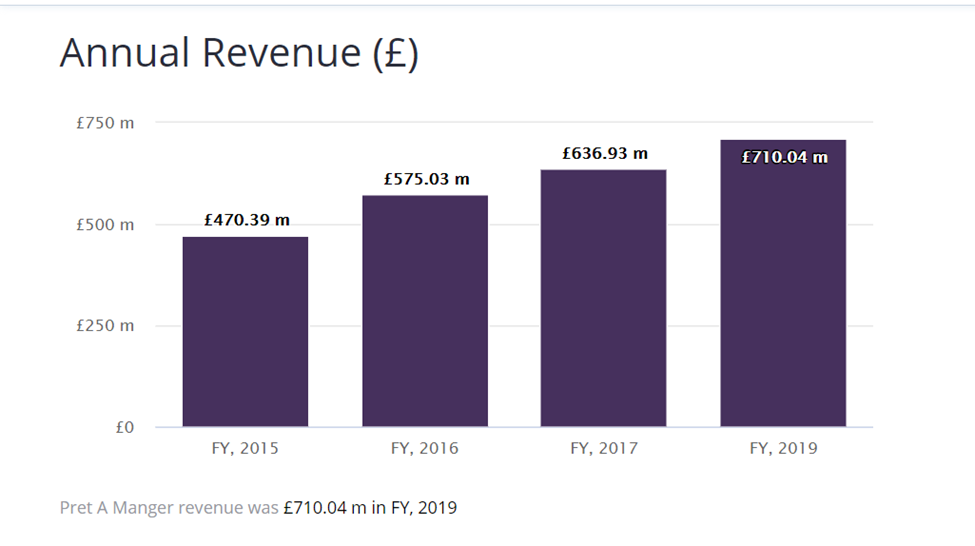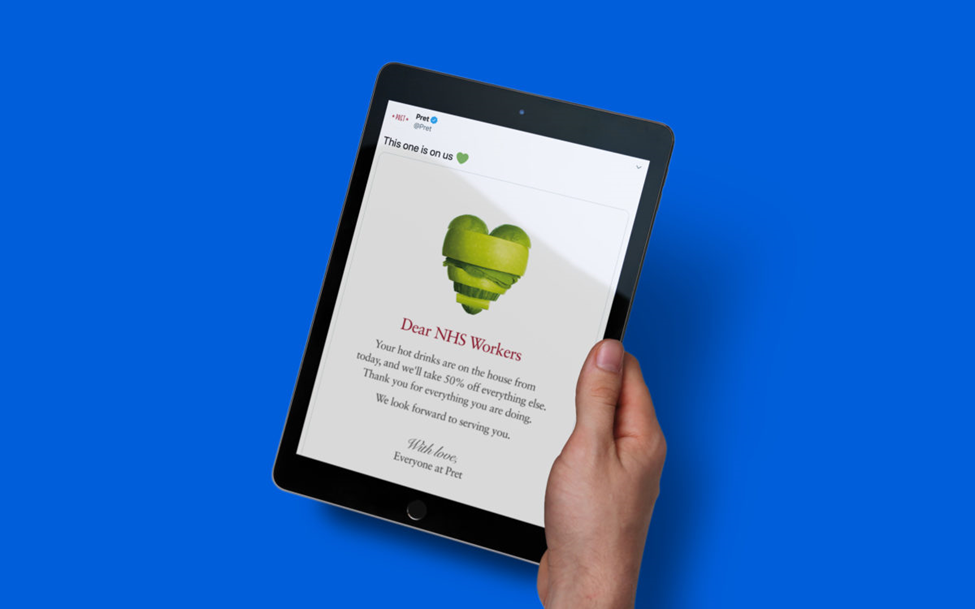Background
The Brand and Market Statistics
This work looks upon brand activism executed by the UK chain of coffee shops Pret A Manger. Pret A Manger positions itself as a retailer of high-quality, natural, ready-to-eat sandwiches, salads, and drinks. Despite the pandemic, its revenue is not falling due to recent initiatives. In 2019, Pret A Manger bought its competitor, the UK chain EAT, at the outset of the pandemic, which allowed Pret A Manger to increase its market share (Harriet, 2020. Picture 1). Today Pret A Manger is one of the leading café chains in London; its revenues in 2019 reached 710.04 pounds (Annual revenue. Picture 2). Having the largest market share among coffee chains in London, the company’s shares in other UK cities are not big, due to which its overall share in the country is meager. The company’s plans to open new outlets at neighborhood locations outside London in a bid to diversify sales are aimed at correcting this situation.

The Target Segments
The target segment for these brands is middle-income families and single people of different age groups. Being natural, the food is not that cheap to attract low-income segments; at the same time, Pret A Manger can hardly compete with restaurants for wealthier customers. Families with children would be attracted by natural ingredients and the perfect taste of the food and drinks; the café’s new delivery proposals may be interesting for all age groups, especially for the older generation.
The Brand Activism Executed
The company engaged in new brand activism at the height of the pandemic. It proposed to serve coffee and tea to NHS workers for free, in gratitude for everything they were doing and a 50% discount on all food to medical workers (Brand positioning in a pandemic: The best brand responses to COVID-19 (Picture 2). The pictures of this activism appeared on the company site’s main page. Moreover, the banners with this activism were hung in all cafes of the chain so that everyone could see it.

Evaluation of Effort
Lenses of Brand Political Activism
From a brand political activism lenses perspective, this initiative relies heavily on the corporate citizen view. The company shows solidarity and support for people working extra hours in the heat of the crisis. People can be seen as one in their fight against the epidemic. Using this activism Pret A Manger shows that the company is aware of the difficulties healthcare system experienced in this period and wants to make its contribution to the final triumph over the illness.
Activism’s Effectiveness
Theories of Attitude Formation/Attitude Change in Assessing Effectiveness of the Chosen Activism
This activism quickly gained support and spread through social networks and social media. The success may be explained by the learning theory of attitude formation, developed by Bandura and elaborated by Hovland (Kolb, Boyatzis & Mainemelis, 2014). This theory singles out three models of learning: the model of classical conditioning and the model of instrumental training and learning through observation (Kolb, Boyatzis & Mainemelis, 2014). In this particular example, all three concepts play a role in forming a positive view of this initiative in peoples’ minds. Personal experience plays an important role there, as getting high-quality hot drinks for nothing would certainly feel HNS workers feel better, especially on cold days.
Instrumental conditioning works here reversely since NHS workers do not get any reward for choosing Pret A Manger brands, but the brand itself may be seen as a reward for hard work. Nevertheless, it may be a worthy reverse alternative in this context since NHS workers may get used to get a sort of prize at the end of a hard day and choose this brand after the pandemic is over to reward themselves after long workdays. People of other professions are likely to learn from observation; seeing a queue of NHS workers waiting for their drinks; they might feel this brand is an excellent choice.
The Impact of This Activism on the Target Consumer’s Decision-Making Process
I think the activism described will tremendously impact the consumer’s decision-making process. First of all, companies that show social responsibility in times of crisis are more likely to be seen positively and be the first choice of customers. Secondly, NHS workers may later choose this brand out of gratitude for support during Covid-19 times. When the pandemic is over, they are as likely as not to get used to choosing this brand for their drinks and snacks since by experience, they would know it is a good one. Finally, people of another profession may choose this brand for its pro-active social position, thus making their own contribution to the prosperity of society.
An Impact on the Consumer’s Decision-Making Heuristics
In my opinion, the described brand activism will have a significant impact on decision-making heuristics. Descriptive theories of judgment may be instrumental in explaining how this impact will be made. According to ‘availability heuristics,’ the choices are inferred from recent events that significantly impact opinions. In the case of Pret A Manger brands, the public and NHS workers, in particular, may be taught to see Pret A Manger brands as socially friendly. They may buy them again and again even when the pandemic is over. Representative heuristics that traces the connection between the current events and events that took time a long time ago will be at work here, too, since buying from Pret A Manger during the pandemic may bring about certain stances that it would later be hard to disrupt.
From the viewpoint of normative theories, the rationale behind choosing Pret A Manger brands would be saving money on the part of NHS workers and supporting the social cause on the part of people engaged in other fields. Social judgment theory may come into play here, too, since collecting evidence from different sources and looking at drinks and food brands from different angles may be beneficial for deciding to buy these products. For example, from a social perspective, the company supports medical workers on the frontline, which is appealing. From the standpoint of how good these products are, they are natural and do not contain any chemicals. From the money perspective, the products are of average price, so many people can afford them. Considering all the above-mentioned perspectives, the choice for Pret A Manger drinks can be made.
The “Word on the Street” Regarding This Brand Activism
The public welcomed the initiative; the news quickly spread through social networks, and the number of ‘likes’ for Pret A Manger brand activism rapidly grew. However, with the influx of NHS workers, the management faced difficulties they were not prepared for. The queues increased dramatically, which disappointed long-term customers of the chain. One customer in Trustpilot says: “I have always loved Pret since the day they started. Food and coffee are always excellent, and service is always super fast until today when I had to wait 10 minutes for a flat white. Come on, Pret you used to have the coffee in my hand within a minute, you were a class above the rest in that important respect” (Reviews, 2021). The other comments highlight delays too; the level of service dropped as busy managers tried to satisfy everyone.
Recommendation
Regarding the given example of activism, I would recommend Pret A Manger to serve drinks to NHS workers with payment only for delivery. This way, NHS workers still get the drinks for free; they can have a cup of hot tea or coffee in the middle of the day to get warmer and feel better. Moreover, it would help reduce the queues at the cafes and not lose customers who appreciate Pret A Manger not only for the quality of food but also for the quality of service.
References
Brand positioning in a pandemic: The best brand responses to COVID-19.
Harriet, D. EAT disappears from high street after cafe chain bought by Pret. Financial Mail on Sunday, 2020.
Reviews (2021).